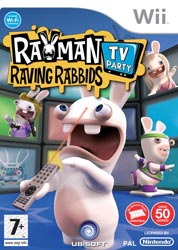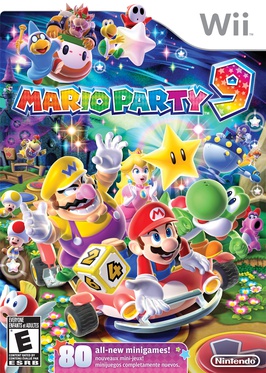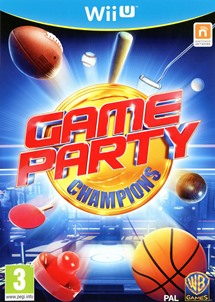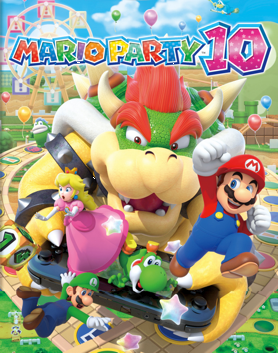
Mario Party 2 is a 1999 party video game developed by Hudson Soft and published by Nintendo for the Nintendo 64. The second game in the Mario Party series, it was released in Japan in December 1999 and worldwide in 2000. The game received mostly positive reviews, who praised the improvements they made to the original, the multiplayer and minigames, but criticized the lack of originality, while graphics received a better but otherwise mixed response.

Mario Party is a party video game series featuring characters from the Mario franchise in which up to four local players or computer-controlled characters compete in a board game interspersed with minigames. The games are currently developed by NDcube and published by Nintendo, being previously developed by Hudson Soft. The series is known for its party game elements, including the often unpredictable multiplayer modes that allow play with up to four, and sometimes eight, human players or CPUs.

Rayman Raving Rabbids is a 2006 party video game developed and published by Ubisoft. It's a spinoff for the Rayman series and the debut title for the Rabbids franchise. The story follows Rayman as he was interrupted by earthquake in which then he was being kidnapped and forced to played minigames with the Rabbids. The game received generally positive reviews from critics, with some criticizing the minigames either being broken or unenjoyable.
Nicklas Nygren, better known by the handle Nifflas, is an independent Swedish video game developer. He is known for his freeware Knytt series and along with another freeware game, Within a Deep Forest. He has lived in Umeå, Sweden and Copenhagen, Denmark.

Rayman Raving Rabbids 2 is a party video game developed and published by Ubisoft. The sequel to Rayman Raving Rabbids and the second installment of the Raving Rabbids spin-off franchise, it was released for the Wii and Nintendo DS platforms worldwide in 2007. It follows the Rabbids' attempt to invade Earth, with their headquarters set up near a local shopping mall. Players have the option to play as a Rabbid or as Rayman, who has disguised himself as a Rabbid to infiltrate their plans. This is the first Rayman game to have an E10+ rating by the ESRB, a greater emphasis on simultaneous multiplayer gameplay compared to the original game, and online leaderboards. It was followed by Rayman Raving Rabbids: TV Party in 2008.

Rayman Raving Rabbids: TV Party is a party video game developed and published by Ubisoft in 2008 and is the third and final installment in the original Rayman Raving Rabbids' trilogy.

Mario Party 9 is a 2012 party video game developed by NDcube and published by Nintendo for the Wii. The ninth main installment in the Mario Party series, it was announced at E3 2011 and released in Europe, North America, and Australia in March 2012, followed by Japan a month later. It was the first game in the series not to be developed by Hudson Soft, which was acquired and dissolved by Konami on March 1, 2012, the day before the game's European release. Instead, development was taken over by Nintendo studio NDCube. This was also the final Mario game to be released on the Wii.

Super Mario is a Japanese multimedia franchise created by Japanese game designer Shigeru Miyamoto for video game company Nintendo which produces and publishes its installments. Starring the titular Italian plumber Mario, it is primarily a video game franchise, but has extended to other forms of media, including television series, comic books, a 1993 feature film, a 2023 animated film and theme park attractions. The series' first installment was 1983's Mario Bros., although Mario had made his first appearance in 1981's arcade game Donkey Kong, and had already been featured in several games of the Donkey Kong and Game & Watch series. The Mario games have been developed by a wide variety of developers including Nintendo, Hudson Soft, and AlphaDream. Mario games have been released almost exclusively for Nintendo's various video game consoles and handhelds, from the third generation onward.

Raving Rabbids: Travel in Time is a party video game developed and published by Ubisoft for the Wii. It was released in North America on November 21, 2010, in Europe on November 26, 2010, in Australia on November 25, 2010 and in Japan on January 27, 2011. It is the fifth installment in the Rabbids series and, unlike the previous entry, Rabbids Go Home, it returns to the party game genre.

Wii Play: Motion is a video game for the Wii console and the sequel to the 2006 game Wii Play. It was released in North America on June 13, 2011; Europe on June 24; Australia on June 30; and Japan on July 7, 2011.

Raving Rabbids: Alive & Kicking known as simply Rabbids: Alive & Kicking, and as Rabbids: Fuori di schermo in Italy, is a Xbox Kinect party video game developed by Ubisoft Paris and Ubisoft Milan and published on December 26, 2011 in Australia, February 10, 2012 in Europe and March 20, 2012 in North America for the Xbox 360. This is the sixth game from the Rabbids games franchise and it is the first Rabbids game not released on the Nintendo Wii. The game was exclusively developed for the Kinect and consists of mini-games with up to 4 players.

The Wii U GamePad is the standard game controller for Nintendo's Wii U home video game console. Incorporating features from tablet computers, the GamePad has traditional input methods, touchscreen controls, and motion controls. The touchscreen can be used to supplement a game by providing alternate, second screen functionality or an asymmetric view of a scenario in a game. The screen can also be used to play a game strictly on the GamePad screen without the use of a television display. Conversely, non-gaming functions can be assigned to it as well, such as using it as a television remote.

ZombiU is a first-person survival horror video game developed by Ubisoft Montpellier and published by Ubisoft. It was released for the Wii U as one of its launch games in November 2012. In the game, the player assumes control of a human survivor amid a 2012 zombie apocalypse. Featuring a permadeath system, it uses the Wii U GamePad extensively to scan the environment and maintain the survivor's inventory. The game was released under the name Zombi for PlayStation 4, Windows, and Xbox One in 2015. The port, handled by Straight Right, adds new melee weapons and removes the multiplayer feature.

Wii Fit U is an exergaming video game developed by Nintendo for the Wii U console, and is the successor to the Wii games Wii Fit and Wii Fit Plus. Wii Fit U utilizes both the Wii Balance Board and the Wii U GamePad in gameplay, and is bundled with the newly introduced Fit Meter, an activity meter accessory. It was released in Japan on October 31, 2013, followed by North America and Europe one day later. It is also the only game on the system to support the balance board.

Nintendo Land is a party video game developed and published by Nintendo as a pack-in launch title for the Wii U home video game console in 2012. The game was first announced at E3 2012 during Nintendo's press conference.

Game & Wario is a 2013 party video game developed by Nintendo and Intelligent Systems and published for the Wii U console, named after LCD Game & Watch titles. It is the eighth installment in the WarioWare series and part of the larger Mario franchise. The story stars Wario and his friends, who take advantage of a newly released video game console with two separate screens by making games for monetary gain. Game & Wario consists of 16 minigames that exclusively utilize the Wii U GamePad and its functions. Additional modes and collectibles are also unlockable. The majority of the minigames are single-player, although some are designed for multiplayer only.

Game Party Champions is the fifth video game in the Game Party series, releasing as a launch title for the Wii U console in North America and Europe. It is the successor to Game Party: In Motion.

Family Party: 30 Great Games Obstacle Arcade is a party game released for the Wii U. It was developed by Art Co., Ltd and published by D3 Publisher. The game was released in November 2012 for the PAL region, and in December for North America and Japan. The game was panned by critics.

Mario Party 10 is a 2015 party video game developed by NDcube and published by Nintendo for the Wii U video game console. It is the tenth home console release in the Mario Party series and a part of the larger Mario franchise. Featuring gameplay similar to the prior series entries, players compete against each other and computer-controlled characters to collect the most mini-stars, traversing a game board and engaging in minigames and other challenges. There are multiple game modes, including one where players traverse a board in a vehicle, sabotaging each other and making choices to collect the most mini-stars by the end. Mario Party 10 adds two modes over its predecessors: Bowser Party, where four players compete in a team against a fifth who controls Bowser on the Wii U GamePad, and Amiibo Party, where players use Amiibo figures. Their gameplay is interspersed by over 70 minigames with various play styles.

Wii Party U is a party video game developed and published by Nintendo for the Wii U in 2013. It was announced in a January 2013 Nintendo Direct, and later detailed at E3 2013 and the October 2013 Nintendo Direct. It is the sequel to the 2010 Wii game Wii Party.



















